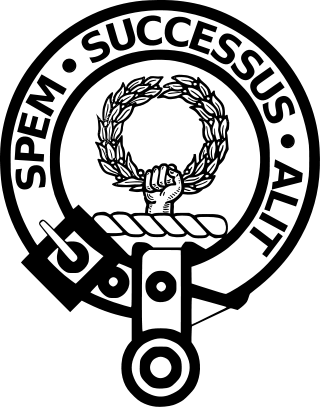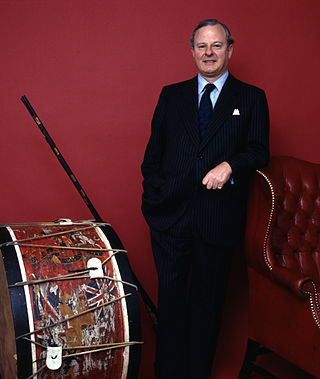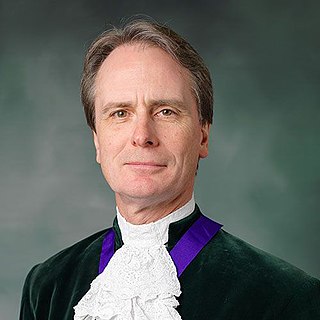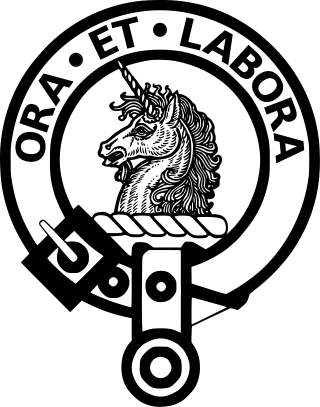| Clan Carnegie | |||
|---|---|---|---|
 | |||
| Motto | Dred God | ||
| Profile | |||
| District | Angus | ||
| Chief | |||
 | |||
| David Carnegie | |||
| His Grace the 4th Duke of Fife | |||
| Seat | Elsick House | ||
| |||
| |||
Clan Carnegie is a Lowland Scottish clan.
| Clan Carnegie | |||
|---|---|---|---|
 | |||
| Motto | Dred God | ||
| Profile | |||
| District | Angus | ||
| Chief | |||
 | |||
| David Carnegie | |||
| His Grace the 4th Duke of Fife | |||
| Seat | Elsick House | ||
| |||
| |||
Clan Carnegie is a Lowland Scottish clan.
Walter de Maule made a grant of the lands and barony of Carnegie, in the parish of Carmyllie, Angus to John de Balinhard in 1358. [1] However, there is no certain record of the origins of the Balinhards, except that their lands were near Arbroath, Angus. [1] Alexander Nisbet suggested that the Balinhards were related to the Ramsays, although there is no direct evidence to support this. [1]
In about 1401 Duthac de Carnegie acquired part of the lands of Kinnaird, in Forfarshire (Angus). [1] They subsequently owned them from Robert Stewart, Duke of Albany in a charter dated 21 February 1409 confirming the lands. [1] Duthac de Carnegie was killed at the Battle of Harlaw in 1411. [1] He left an infant son, Walter Carnegie of Kinnaird who fought for James II of Scotland at the Battle of Brechin in May 1452 along with the Earl of Huntly. [1] Their enemies were rebels commanded by the Earl of Crawford (chief of Clan Lindsay) who were defeated. [1] However Crawford, in revenge, burned the village of Kinnaird. [1]
John Carnegie of Kinnaird fought at the Battle of Flodden where he was killed in 1513. [2] [1] His son was Sir Robert Carnegie who extended Kinnaird and was appointed one of the judges of the College of Justice in 1547. [1] He was also sent to England in 1548 to negotiate the ransom of the Earl of Huntly who had been captured at the Battle of Pinkie Cleugh. [1] Sir Robert Carnegie is said to have been the first of the family to claim that his ancestors were cup bearers to the king of Scots and the family arms bear an antique cup as reference to this royal office. [1]
Sir Robert's son was John Carnegie who was a faithful and loyal adherent to Mary, Queen of Scots and unlike many he never abandoned his loyalty to the queen. [1] He died in 1595 and the estates passed to his younger brother, Sir David Carnegie. [1]
David Carnegie was created Lord Carnegie of Kinnaird in April 1616 and was later advanced to the rank of Earl of Southesk in June 1633. [1] Sir John Carnegie, brother of David, was elevated to the peerage in 1639 as Lord Lour and was created Earl of Ethie in 1647. [1]
James Carnegie, 2nd Earl of Southesk attended the exiled king Charles II of England in Holland in 1650. [1] He was also one of the Commissioners chosen to sit in the Parliament of England for Scotland during The Protectorate. [1] He was nearly killed however, in a duel with the Master of Gray in London in 1660. [1] The younger son of the third Earl did not have such a fortunate duelling career and was killed in 1681 in Paris by William, son of Elizabeth Maitland, Duchess of Lauderdale. [1]
The Clan Carnegie were Jacobites. [1] The fourth Earl took no part in opposing the Glorious Revolution of 1688 but afterwards shunned the royal court. [1] His son, the fifth Earl, followed the Old Pretender during the Jacobite rising of 1715 and as a result was attained by an Act of Parliament and his estates were forfeited to the Crown. [1] The fifth Earl died in 1730 and all of his children had died young, as was the high rate of infant mortality at the time. [1] He was succeeded by John Carnegie of Pittarrow who was descended from a younger son of the first Earl. [1] This line of Carnegies had been created Baronets of Nova Scotia in 1663. [1]
The sixth Baronet was a distinguished soldier and in 1855 he was able to secure an Act of Parliament that reversed the attainder and restored the titles of Earl of Southesk as well as Lord Carnegie of Kinnaird and Leuchars. [1] The ninth Earl chose the title of Baron of Balinhaird in reference to his family's origins and early ancestry. [1]
The eleventh Earl married Her Highness Princess Maud, younger daughter of the Princess Royal and granddaughter of Edward VII. [1] Her son, as well as being heir to his father's earldom of Southesk and chief of Clan Carnegie, also inherited the dukedom of Fife which was the title of his maternal grandfather. [1] The eleventh Earl died in 1992 and his son, the Duke of Fife, succeeded as chief of the clan and the earldom of Southesk was kept as a subsidiary title in honor of his Carnegie ancestors. [1]
The Carnegie tartan, based on the Glengarry tartan, was adopted in these times.
As of 2015 [update] the clan chief, with full titles, was His Grace David Carnegie, 4th Duke of Fife, Earl of Southesk, Earl of Macduff, Lord Carnegie of Kinnaird, Lord Carnegie of Kinnaird and Leuchars, Baron Balinhard of Farnell, Baronet and Chief of the Name and Arms of Carnegie. [3]

Clan Ross is a Highland Scottish clan. The original chiefs of the clan were the original Earls of Ross.

James George Alexander Bannerman Carnegie, 3rd Duke of Fife was a British landowner, farmer and peer. He was the grandson of Louise, Princess Royal, a daughter of King Edward VII and Queen Alexandra. As a female-line great-grandson of a British sovereign, he did not carry out royal or official duties or receive any funds from the Civil List. He was the second cousin of Queen Elizabeth II and Princess Margaret, Countess of Snowdon, and King Harald V of Norway. Through his maternal grandfather, he was also a descendant of William IV and Dorothea Jordan.

Duke of Fife is a title in the Peerage of the United Kingdom that has been created twice, in both cases for Alexander Duff, 1st Duke of Fife and 6th Earl Fife, who in 1889 married Princess Louise, the eldest daughter of Albert Edward, Prince of Wales. The dukedom of Fife was created for a member of the British royal family by marriage, since the first holder's wife was a granddaughter of Queen Victoria.

Earl of Southesk is a title in the Peerage of Scotland. It was created in 1633 for Sir David Carnegie, an Extraordinary Lord of Session. He had already been created Lord Carnegie of Kinnaird in 1616 and was made Lord Carnegie, of Kinnaird and Leuchars, at the same time he was given the earldom. These titles are also in the Peerage of Scotland. The earldom is named after the River South Esk in Angus. Carnegie's younger brother John Carnegie was given the corresponding title: earl of Northesk. The earl of Southesk also holds the Scottish feudal title of Baron of Kinnaird and is a baronet in the Baronetage of Nova Scotia. Kinnaird Castle, Brechin, has been the home of the earls of Southesk for several hundred years.

Clan Donald, also known as Clan MacDonald, is a Highland Scottish clan and one of the largest Scottish clans. The Lord Lyon King of Arms, the Scottish official with responsibility for regulating heraldry in that country, issuing new grants of coats of arms, and serving as the judge of the Court of the Lord Lyon, recognises under Scottish law the High Chief of Clan Donald. Historically the chiefs of the Clan Donald held the title of Lord of the Isles until 1493 and two of those chiefs also held the title of Earl of Ross until 1476.

Clan Mackay is an ancient and once-powerful Highland Scottish clan from the far North of the Scottish Highlands, but with roots in the old Kingdom of Moray.

Clan Shaw is a Highland Scottish clan and is a member of the Chattan Confederation.

Clan Gordon is a Highland Scottish clan, historically one of the most powerful Scottish clans. The Gordon lands once spanned a large territory across the Highlands. Presently, Gordon is seated at Aboyne Castle, Aberdeenshire. The Chief of the clan is the Earl of Huntly, later the Marquess of Huntly.

David Charles Carnegie, 4th Duke of Fife is a British peer and businessman. He is the only surviving son of the late James Carnegie, 3rd Duke of Fife, and his former wife Caroline Dewar. He was styled Earl of Macduff until 1992, and then Earl of Southesk until succeeding his father on 22 June 2015 as the fourth Duke of Fife and Chief of the Clan Carnegie. He is the highest person in line of succession to the British throne who is not a descendant of George V. He is a third cousin of King Charles III.

Clan Ramsay is a Lowland Scottish clan.
Charles Alexander Bannerman Carnegie, 11th Earl of Southesk, styled The Honourable Charles Carnegie before 1905 and Lord Carnegie between 1905 and 1941, was the husband of Princess Maud, a granddaughter of King Edward VII.

James Carnegie, 9th Earl of Southesk, KT, DL was a Scottish nobleman, explorer and poet.

Clan Sutherland also known as House of Sutherland is a Highland Scottish clan whose traditional territory is the shire of Sutherland in the far north of Scotland. The chief of the clan was also the powerful Earl of Sutherland, however in the early 16th century this title passed through marriage to a younger son of the chief of Clan Gordon. The current chief is Alistair Sutherland who holds the title Earl of Sutherland.

Clan Erskine is a Scottish clan of the Scottish Lowlands.

Clan Ogilvy/Ogilvie is a Scottish Highland clan from Angus, Scotland. Gillebride, Earl of Angus, received a barony from King William the Lion in 1163 and bestowed the lands of Ogilvy upon his son Gilbert. In 1491, King James IV elevated Sir James Ogilvy as Lord Ogilvy of Airlie.
Sir James Carnegie of Kinnaird and of Pitarrow, 5th Baronet DL was a Scottish politician and de jure8th Earl of Southesk, 8th Baron Carnegie of Kinnaird and 8th Baron Carnegie of Kinnaird and Leuchars.
Sir James Carnegie of Pittarrow, 3rd Baronet was a Scottish politician, soldier and 6th Earl of Southesk, 6th Baron Carnegie of Kinnaird and 6th Baron Carnegie, of Kinnaird and Leuchars.
Charles Noel Carnegie, 10th Earl of Southesk JP DL, was a Scottish nobleman.
Robert Carnegie, 3rd Earl of Southesk was a Scottish nobleman.
David Carnegie of Colluthie (1559–1598) was a Scottish landowner and administrator.